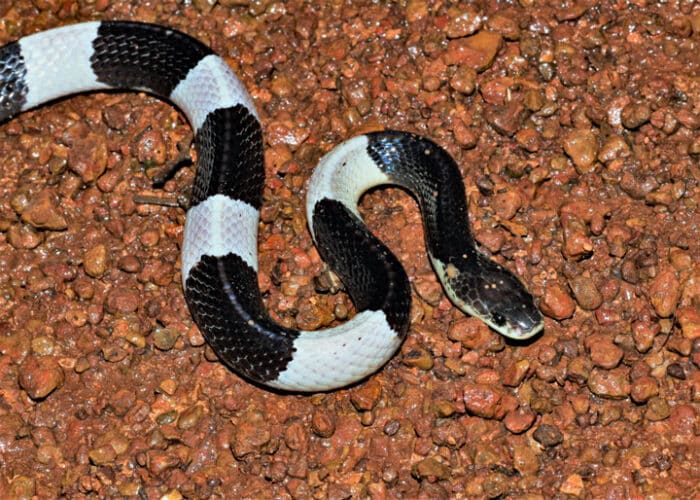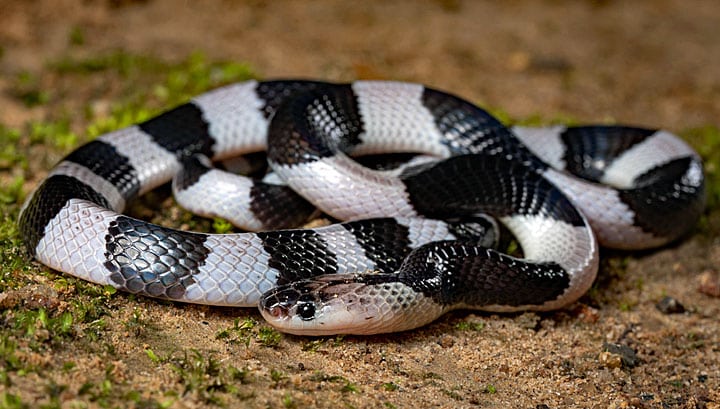
The Malayan krait, or blue krait, is a highly venomous species of snake and member of the Elapidae family. The snake is found in Southeast Asia and from Indochina in the south to Java and Bali in Indonesia.
The Blue krait, also known as the Malayan krait (Bungarus candidus), is one of the most intriguing and venomous snakes to encounter in Southeast Asia. They are nocturnal animals, meaning they are mainly active at night and rest during the day.
Blue kraits are easily identified by their distinctive appearance. They have a slender body, which can range in length from about 1 to 1,5 meters, and are covered in distinctive blue-black and white bands. This color combination serves as a warning to predators that the snake is venomous and should be left alone.
The Blue krait's diet consists mainly of other snakes, but they also prey on lizards, amphibians and small mammals. They are highly efficient hunters and use their neurotoxic venom to quickly paralyze and kill their prey. Although they are not naturally aggressive towards humans, a bite from a Blue krait can be fatal. Their venom is very potent and can cause respiratory failure and paralysis, which can eventually lead to death.
An interesting aspect of the Blue krait's behavior is that they often coexist with other snakes, even of other species. This social behavior, which is rare among snakes, can help them stay warm and feel safer from predators.
Although relatively numerous in some parts of their range, Blue kraits are at risk of being threatened by habitat loss and human activities. Deforestation and land conversion for agriculture and urban development can lead to a decrease in their habitat and food resources. In addition, they are sometimes killed by people seeking to use their venom for medicinal purposes or for fear of their potentially deadly bite.
In short, the Blue krait is a fascinating and venomous snake that plays an important role in the ecosystems of Southeast Asia. To protect this species, it is important to preserve their habitat and raise awareness about their ecological importance and the dangers they can pose to unwitting people.
Special features and characteristics of the Blue krait or Malayan krait (Bungarus candidus)
- Name in English: Malayan krait.
- Name in Thai: งูทับสมิงคลา, ngu thap saming khlaa.
- Scientific name: Bungarus candidus (Carolus Linnaeus – 1758).
- Is found in: Southeast Asia and from Indochina in the south to Java and Bali in Indonesia.
- Eating pattern: Mammals including mice.
- Toxicity: Very toxic. An untreated bite causes a mortality rate of 60-70% in humans.



My great appreciation for this contribution and in particular about snakes in Thailand.
We, as Dutch travelers to Thailand, have relatively little personal experience with (venomous) snakes.
Although I live on the 9th floor I always have the toilet seat down and keep in mind that snakes in the sewer system hunt for rats and can unintentionally pop up in your toilet (snake meets snake!)
This is not inconceivable since a snake was previously found on a balcony (also on the 9th floor and it arrived through the floor drain).
You shouldn't have to remember it (you know what I mean), but yes, that is also part of a stay in this region.
Always look before you sit down!
In fact, there is currently no active anti-serum against a bite from this snake.
Although this snake has a reputation for rarely biting, always handle it with great care.
It is also a good tip if you have been bitten by a snake to take a picture of the snake with your mobile phone and show it in the hospital. This saves the doctors time in assessment and can save your life.
See Ton's extensive response to the 2nd item of this series of 3 January. With an extensive treatise on antidotes for various snakes.
That is not correct, there is indeed an antidote, both a monovalent and a polyvalent.
On this link you can find the various antivenoms.
https://www.saovabha.com/en/product_serum.asp?nTopic=2
Whether you survive is another matter.
That depends a lot on how early you get to the doctor.
The problem with the venom of these kraits is that it is purely neurotoxic, so it doesn't hurt.
So people sometimes do not know that they have been bitten or think that no poison has been injected because they do not feel anything. Until the paralysis symptoms start to appear after some time…
I've often heard that even with antidotes 50% of cases are unrecoverable, but frankly I've never seen the scientific research to prove this, so that may well be a false 'fact'.
But there is no doubt that the venom of this species, at least when tested on mice, is the strongest of any land snake species in Thailand.
Small niggle, the krait species mainly eat other snakes.
And there are some harmless wolf snake species that look very similar. So a white and black barred snake is not necessarily dangerous.